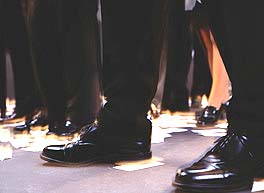
| ||||||||||||||
 |
Smelly Feet - Consumer info
Smelly FeetSmelly feet can be not only embarrassing but very uncomfortable. But once you understand the problem, you'll be able to take steps to reduce the odor.
What causes foot odor? Feet smell for two reasons:
The interaction between your perspiration and the bacteria that thrive in your shoes and socks generates the odor. So any attempt to reduce foot odor has to address both your sweating and your footwear. The feet and hands contain more sweat glands than any other part of the body (about 3,000 glands per square inch) and provide a ready supply of perspiration. You're probably familiar with the phenomenon of sweaty palms, but sweat on your hands doesn't produce the same strong odor as sweaty feet. That's because your hands are usually exposed to the air and the sweat has a chance to evaporate. Feet, however, are trapped inside shoes, where temperatures can easily reach 102 F. The perspiration moisture combines with the dark warmth to create a fertile breeding ground for the bacteria that normally live on our skin. The bacteria produce isovaleric acid, the substance associated with foot odor. The more moisture there is, the more bacteria proliferate, and the greater the odor. Smelly feet can also be caused by an inherited condition called hyperhidrosis, or excessive sweating, which primarily affects males. Stress, some medications, fluid intake and hormonal changes also can increase the amount of perspiration your body produces.
Socks
containing We do sell in bulk only - a pallet load is the minimum If you are able to purchase pallet loads or know a distributing chain who is interested to carry socks which contain smartcel bioactive fibers please let us know.
Recommendations for preventing foot odor Fortunately, smelly feet generally can be controlled with a few preventive measures. The American Orthopaedic Foot and Ankle Society recommends that you:
These preventive measures also can help prevent athlete's foot, which can flourish in the same environment as sweaty feet. However, athlete's foot won't respond to an antibacterial agent because it's caused by a fungus infection. Use an anti-fungal powder and good foot hygiene to treat athlete's foot.
Treating foot odor Persistent foot odor can indicate a low-grade infection or a severe case of hereditary sweating. In these cases, your doctor may prescribe a special ointment. You apply it to the feet at bedtime and then wrap your feet with an impermeable covering such as kitchen plastic wrap. Soaking your feet in strong black tea for 30 minutes a day for a week can help. The tannic acid in the tea kills the bacteria and closes the pores, keeping your feet dry longer. Use two tea bags per pint of water. Boil for 15 minutes, then add two quarts of cool water. Soak your feet in the cool solution. Alternately, you can soak your feet in a solution of one part vinegar and two parts water. A form of electrolysis called iontophoresis also can reduce excessive sweating of the feet, but requires special equipment and training to administer. In the most severe cases of hyperhidrosis, a surgeon can cut the nerve that controls sweating. Recent advances in technology have made this surgery much safer, but you may notice compensatory sweating in other areas of the body afterwards.
| |||||||||||||
| Be notified of page updates |
wwwswicofilcom2015

